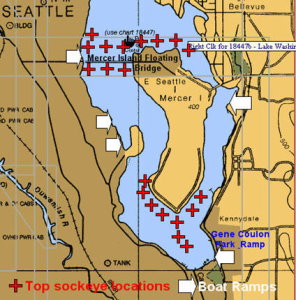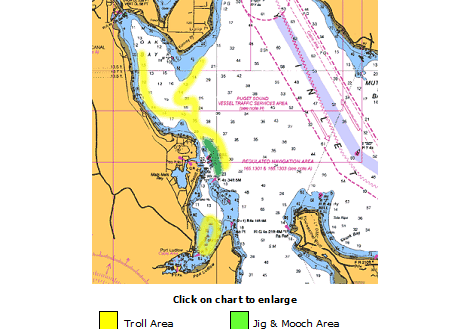Puget Sound North
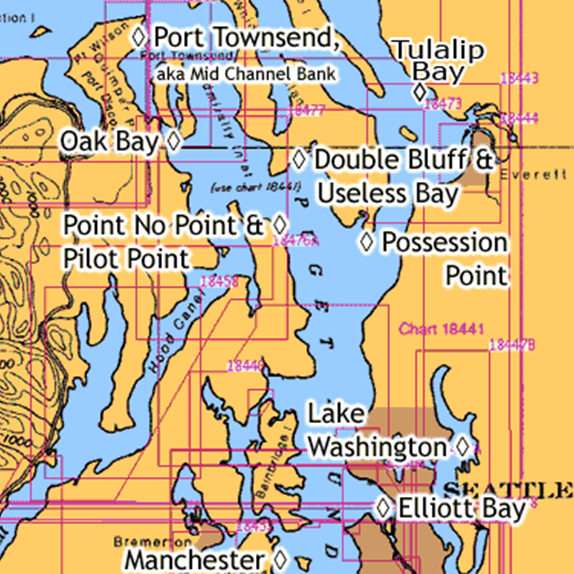
North Puget Sound is one of the best places to fish in the state. All of the runs coming to the south Puget Sound must, of course, pass through north Puget Sound waters first. This is your first chance to intercept them. Select a region to learn more:
- Double Bluff and Useless Bay
- Elliott Bay
- Lake Washington
- Manchester
- Oak Bay
- Point No Point and Pilot Point
- Possession Point
- Port Townsend
- Tulalip Bay
Double Bluff and Useless Bay
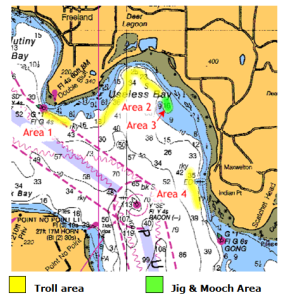 Double Bluff and Useless Bay are often overlooked. Located north of Point No Point and west of Possession Point, this area consistently produces salmon. It also offers uncrowded fishing!
Double Bluff and Useless Bay are often overlooked. Located north of Point No Point and west of Possession Point, this area consistently produces salmon. It also offers uncrowded fishing!
Area 1
Double Bluff is best fished on the incoming tide, trolling west to east. Try to stay in 70 to 90 ft. of water. A little tricky, as the drop off is quite steep.
The bait in this area is usually predominately herring, so bigger lures and bait are called for in this spot. The Silver Horde 5” plug works well here. Fish your plugs 35-ft. to 50- ft. behind your release clip. Touch your plugs or lures up with Smelly Jelly
Flashers and #35 Gold Squid also work well here. While herring will also work you may have trouble keeping dogfish off your hook.
If you are fishing for winter Blackmouth and have a third rod out, try trolling with a Pirate Color Hot Shot or Wiggle Wart Steelhead Plug. During the winter months, its not uncommon to pick up a Steelhead here.
In the fall, this is a deadly combination for Coho. Fish your Hot Shot about 30-ft. behind your boat in the early dawn hours and drop it back about 85-ft. after the sun is on the water.
Area 2
Useless Bay can be fished on either tide. Follow the 90-ft. to 120-ft. shelf. This is primarily a Blackmouth or Chinook area. Don’t be surprised if you pick up a Halibut in this area.
Area 3
A pocket surrounded by shallow flats. This area is usually good for a fish or two for the dedicated moocher or jigger.
Area 4
Indian Point is not much of a point. This is an area where the fall Coho passing Bush Pt. and Double Bluff gather before moving onto Possession Bar. Fish the rips for Coho. The Silver Horde Coho Killer and the above mentioned steelhead plugs work well here. Troll as fast as your gear will allow.
Elliott Bay
 Even after 50 years of fishing in Elliott Bay, it’s hard to lose your enthusiasm for this area. Elliott Bay has always had good year-round fishing opportunities.
Even after 50 years of fishing in Elliott Bay, it’s hard to lose your enthusiasm for this area. Elliott Bay has always had good year-round fishing opportunities.
Summer Chinook return in good numbers to the Duwamish River and its tributaries. Winter blackmouth (if bait is present) are usually in the bay in good numbers from November through March. Coho fishing usually is a little slower than other areas in Puget Sound. Coho return in good numbers but are not always aggressive biters.
All fishing within Elliott Bay is controlled by the seasons set by the Department of Fish and Wildlife, and of course tribal netting. Therefore, read your regulations and pray the tribal fishermen haven’t cleaned out the bay the night before you fish.
Winter blackmouth fishermen also have the opportunity to participate in one of the most unique salmon derbies anywhere. The Tengu Derby is the oldest derby in Washington and open to moochers only. This is appropriate, as Elliott Bay is where the word moochers originated.
While the areas to fish in Elliott Bay remain for the most part the same, terminal tackle changes with the salmon runs and bait size. Here are some guidelines:
Summer Chinook
The spawning Chinook usually begin arriving in June and by July they are there in good numbers. By August 15th, most Chinook are already in the Duwamish and catch rates drop dramatically.
Bait: of course, is always good. Artificial lures work exceptionally well, as the Chinook are usually off the bite and respond to lures that tend to agitate them.
Plugs: Silver Horde 5 Rattle Plugs fished 32 to 50 feet behind your release clip are always a good choice. Pearl White and Glo Green Plugs are the best.
Squid: Silver Horde #35 Squid fished 42 to 44 inches behind a flasher with your top hook tipped with a herring teaser is very effective.
Spoons: Spoons are perhaps the easiest and one of the most productive lures for Elliott Bay. The Sonic Edge spoon in any of the glo colors fished 48 behind a flasher will do the trick.
All of the above artificial lures should be smeared with Smelly Jelly, herring or shrimp scents, or a favorite, Special Mix.
Coho
Resident Coho are usually in the area from June until October. These are first caught in the fishery as one to three pounders in July and by September have reached the six to eight pound range.
Ocean Coho usually start returning about mid-September and the size ranges from 8 pounds to 15 pounds, with a few larger.
A fast troll with lures usually is the ticket. They can be caught on bait, but artificial lures off a downrigger will usually outfish bait, simply because you can troll it faster.
Spoons: A Silver Horde Coho Killer 32 behind a flasher is always good. The Silver Horde #3 Kingfisher spoon is also effective. Both spoons in glo color or the new Cop Car color are efficient catchers. Smelly Jelly on all tackle, but use shrimp or special mix flavors only.
Flasher and Squid combinations: These are always fish catchers, but go down in size. The needlefish squid is a better choice. Shorten your leader length to 32 behind a full size flasher, on a mini flasher (24 to 28 inches is about right). Herring teasers are a must for Coho on a squid, and of course use Smelly Jelly.
Plugs: This is one of the most exciting ways to catch Coho. A twelve-pound Coho slamming a plug 10 feet below the surface can almost tear the rod off your boat. The #35 Rattle Lure Hot Shot is a killer. First of all, Hot Shots are fished by themselves without a flasher. Early in the morning or late in the evening when the sun is not on the water, fish Hot Shots 25 to 35 feet behind your boat. When the sun is on the water, drop your Hot Shots back 65 to 85 feet behind your boat.
Hot Shots can also be effectively fished 35 ft. behind a downrigger for deeper fish as long as you remember your lure will dive another 10 feet deeper than your downrigger depth.
In the fall, go to hot colors for Coho. Use pirate green/red or orange/yellow or combinations are excellent. Always fish Hot Shots with rattles.
Winter Blackmouth
Winter Blackmouth: The fishery for winter blackmouth is a bottom fishery. Most winter blackmouth will be caught in the bottom 20 feet of water.
The moochers really come into their own during this period. Downrigger fishermen also do well. The driving factor on either method is bait. The bait will move in and out of the bay. If the bait is in, there will be good fishing. If there is no bait, go somewhere else.
The best lures to use are Coho Killers and #3 Kingfisher Spoons fished 36 Behind a flasher.
Fishing areas in Elliot Bay
Area 1: This area is best fished on the outgoing tide. Resident Coho are usually there and fall Coho will pass through. A good fishery for Chinook takes place here also. Fish the bottom 20 feet for blackmouth. Fish the top 60 for Coho. Fish the 80 to 150 foot depths for summer Chinook. Watch your depth sounder, as summer Chinook will often suspend and can be at any depth. Fish the top 60 of water at daybreak and in the evening for Chinook. Go deeper on bright sunny days.
Area 2: Essentially the same fishery as Area 1, however, it is best fished on the incoming tide. Troll or motor mooch down to the area just beyond the boat launch. Chinook are often quite close to shore. Stay at least 100 yards off shore from the Seacrest Pier.
The Seacrest Pier is open year-round for shore bound anglers. Chinook, Coho and crab are taken from this pier. A variety of lures are used here, but primarily weighted casting lures (such as Buzz Bombs) and herring rigged below a float.
Area 3: Directly in front of Salty’s restaurant. This is a good area for both blackmouth and Chinook. Moochers should work the shallow waters. If boats or barges are moored here, moochers should try dropping a herring next to them. Trollers should stay in the 100 to 150 foot line. This is a great spot to astound a restaurant full of people when you pull in a big Chinook.
Area 4: This is the primary fishery in Elliott Bay. This is the hot spot, but can become so crowded that it scatters the fish.
Moochers should work the mouths of the waterways, especially the east waterway. If security allows it, fish next to any boats moored in the Todd Shipyard or along the shore. Chinook will move under barges and ships and use them for cover in shallow water.
Trollers should work further outside in the 100 to 150 foot depths. Summer Chinook often suspend, so watch your electronics. Troll almost to the ferry docks.
Area 5: Just south of the ferry dock, in 200 foot or more of water, Chinook will often suspend 60 to 80 feet down from the surface. This is an area to fish on the outgoing tide, as the Chinook will school up before they move into the Duwamish River.
Area 6: This is a moorage area for barges. If barges are moored here, Chinook will move underneath them and use them as cover. A herring dropped in under these barges often results in a solid hookup.
Trollers can circle the barges and usually find Chinook suspended in the 60 to 80 foot depths. Watch your downrigger cables and electronics, as anchors and cables make great downrigger ball collectors.
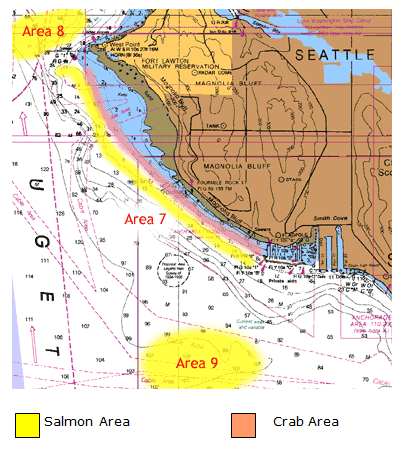 Area 7: This area starts at West Point and continues down almost to the Elliott Bay Marina. This is an excellent trolling area for Chinook, Coho and winter blackmouth. This is a good fishery on either tide. Work the 70 to 150 foot depths.
Area 7: This area starts at West Point and continues down almost to the Elliott Bay Marina. This is an excellent trolling area for Chinook, Coho and winter blackmouth. This is a good fishery on either tide. Work the 70 to 150 foot depths.
There are many flounder in this area, so check your gear quite often.
Good crabbing is available here. Some of the best crabbing is in only 10 to 25 foot depths.
Area 8: Off West Point, in no particular area, but a mixing of tidal currents make this the best place for fall Coho in the Seattle area.
Area 9: Once again, no particular area, but a great fall Coho spot. A mixing of currents and the water being stirred up by ferry and tug boat props seems to stir up the food chain and put the Coho on the bite.
Boat Launches
Armeni Ramp is located on Harbor Avenue in West Seattle on Elliott Bay, 1.1 miles past the Seacrest Boat House. This ramp has a good pitch. A fee is charged for launching.
Shilshole Ramp is located at the Shilshole Bay Marina in Ballard. This is a popular ramp that has lots of space for parking. A fee is charged for launching.
Lake Washington (sockeye)
Here are the top tactics to make your Sockeye fishing successful and fun.
- Sockeye are the best tasting of all five species of Salmon. The easiest to catch and the best family fishing outing in the state of Washington.
- A valid fishing license must be in your possession for everyone in your boat that is 15 years or older. If you have guests that are under 15, they don’t need to purchase a license, but must have a catch record card. You can expect strong enforcement on the water and at the launches.
- The best fishing is not at dawn, but starts about 7:00 AM and continues until about 10:00 AM. After that, due to bright sun and all the gear in the water, the bite slows, but Sockeye can be caught all day. On a cloudy day, you may have Hot Fishing throughout the day.
- The real secret to catching Sockeye is a slow troll (approximately 1 mile per hour).
- Start your fishing early in the morning at the 50-60 foot level. After 7:00 AM drop 5 feet deeper every half hour. By 10:30 AM you want to be fishing at least 85 to 90 feet deep.
- Use the Gold Star 0 Dodger (8 inch) with a 3/O Red Hook, tied 13 to 16 inches behind the dodger.
- Tie hooks with at least 20 lb leader, 40 to 60 pounds is even better.
- Downriggers of course are the most effective way of fishing because it gives you depth control.
- Those of you who don’t own downriggers can do well by using an 8-oz. Weight attached three feet ahead of your Gold Star Dodger. If you use a lighter weight, you won’t be able to reach the depths with any accuracy.
- The more gear you have in the water, the more Sockeye you will hook. Sockeye follow gear. Keep your other rods in the water while landing your hooked Sockeye. This will often result in multiple hook-ups. An extra landing net becomes very handy during these hectic moments.
- Once you have located Sockeye, figure 8 back through the school and chances are you’ll hook more fish in the same spot.
- Oddly enough, on the weekend, which usually means crowded water conditions, speed up slightly (2 – 2 ½ miles per hour). The difference in the action of your dodger will often lead to strikes.
- If your motor won’t troll slow enough, troll in an S shaped pattern. This will slow down the inside rods.
- While many people fish Dipsy Divers, except for very early morning, you simply are not trolling fast enough to get the depth required with this tackle.
Care for Sockeye
After you have landed the best tasting salmon on the West Coast, take time to preserve the flavor. First, a sharp rap on the head to put the Sockeye to sleep. Don’t allow it to thrash around in the boat and get bruised. Second, cut both gills and allow the Sockeye to bleed out, preferably over the side of your boat or in your fish box, not on your boat carpet. Clean your Sockeye as soon as possible and ice it down or cover with wet burlap and store it in a cool place. Don’t let your Sockeye sit in the sun, and even worse, don’t drag your fish on a stringer alongside your boat. On a sunny day, dragging a fish in the water insures a half-boiled fish. Take care of your sockeye and you will have a gourmet delight as good, if not better, than the high priced Copper River and Bristol Bay Sockeye in the markets.
Manchester
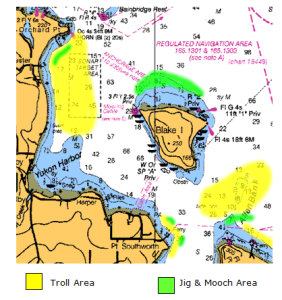 Over the past few years, Manchester pops up more and more frequently among top winter spots for Central Puget Sound salmon fishing.
Over the past few years, Manchester pops up more and more frequently among top winter spots for Central Puget Sound salmon fishing.
This Kitsap Peninsula workhorse sometimes takes a back seat to its well-known cousins Jeff Head just to the north, and Pt. Defiance to the south, but prudent anglers know Manchester provides consistent winter blackmouth action right up to the April 10th closer.
Manchester inlet is one of the most reliable, wind sheltered and close by fisheries for winter blackmouth and is a quick boat ride from Elliott Bay, Tacoma or Bremerton.
This area is good fishing for one simple reason, it holds lots of bait and all good anglers know if you find the bait you will find blackmouth. It’s a really short run from Elliott Bay and about 11 miles from Gig Harbor by water.
One of the great things about fishing Manchester is you’re not restricted to one area, if the bite is off that day you have several other close by options.
Where To Fish
The majority of the fish will be taken between the fuel dock, and the turquoise boathouse located a mile just to the south. This troll or drift for moochers puts out the majority of the fish. The bottom is gently sloping in this area with a relatively smooth bottom, no big ledge or points. This makes mooching a good bet in the 90-100 ft water. Trollers will catch fish out in the deeper water here targeting suspended bait schools that attract the local blackmouth in to feed.
Tide Change
Like most locations in this area the ebb tide seems to be the most favorable. You can catch fish on either tide, and normally the bite will happen 2 hours on either side of a tide change. The bottom is nice with few obstructions to hang up on so you can really get the downrigger balls right down there where Mr. Blackmouth lives.
Seals can be a problem here, so be aware when lots of boats start to show up, so do the salmon belly eaters.
In the Winter, blackmouth normally run from the just legal fish up to 10 pounds and of course there are always a few in the teens taken every year.
Trollers
Work the long trolling path from Orchard Point towards the Navy Fuel dock then in toward Manchester boat ramp and on down south about a mile. This area stays relatively flat with only a couple of humps. The majority of the bait holds in the 90-120 ft water here.
When the bottom starts to come up turn east towards Blake Island and follow this ledge out until the bottom starts to drop off, then it’s a simple turn back North to complete the circle back to Orchard Point and do it again. Pay close attention to the fishfinder when you make the turn north, the bait tends to move up to the mid water depths here and the fish will follow, target just under the bait ball with the rigger, this is where the fish will be feeding.
Mooching
The best mooching happens between the Fuel Dock and the Manchester ramp. There is also great mooching on the North end of Blake Island the shallow bank here can really producer for moochers. The top mooching water is in 80-120 ft. Fish just off the bottom, with 10-12 pound leaders and a tight spinning cutplug herring. Use only the amount of lead you need to stay in contact with the bottom.
Boat Launch
There is a ramp at Manchester, it has a dock and it is only 5 minutes from the best fishing. The parking lot however, is small and won’t hold many rigs.
For the Seattle crowd the Don Armeni boat ramp in Elliot Bay is a straight shot across the Sound from Manchester. There is also a small ramp in the city center of Port Orchard and at Evergreen City Park in Bremerton.
If The Bite Is Off
Head south to Southworth and then run over to Allen Bank. At Southworth there’s a great hole just north of the ferry terminal. Troll the ledge here or move in close and pitch a herring in toward the beach and drift down the ledge.
Allen Bank
Is a great piece of salmon holding water that runs south off the southwest corner of Blake Island north of Vashon outward to perfect blackmouth holding water.
This is a big drift, and almost always there are some fish around waiting to hammer tight spinning bait, even when the Manchester fishing turns off. The blackmouth can be caught here on either tide but the best action is on the ebb.
Moochers will want to run 10-15 pound test main lines, with long 10-12 pound test, 4-5 foot leaders, with a selection of 2-6 oz mooching sinkers. Size your hooks to the bait. Insure the herring has a drill bit like spin in the water.
Oak Bay
Mats Mats Bay is perhaps the best known as the least known salmon area in Admiralty Inlet by salmon anglers. While Mid Channel Bank just to the north in Port Townsend receives all the limelight, anglers venturing just a little south can find excellent winter blackmouth fishing near Mats Mats with half the boat traffic that is typically found on the Bank.
Top action near Mats Mats takes place from the buoy near the mouth of Mats Mats Bay up to Olele Point to the north. You will see boats trolling and mooching this area in the 90-120 ft water.
If the bait moves and you don’t produce fish here, there’s a good troll from Olele Point to Liplip Point along the shelf that forms here. This can be a very productive troll, working the bait that stacks up on this shelf. An “S” trolling pattern works best as this is a long troll. If you score on a fish, circle around and work the same area again until it plays out.
Oak Bay offers another good spot located along the breakline on the western shore where the bottom drops off from 8 fathoms (48ft) to 14 fathoms (84ft). Again, keep your gear in the bottom 10 feet of water.
Moochers, use fresh herring if you can get it, many times you can dip up a ball near Ludlow Bay. If not, use the best frozen brined herring you can get.
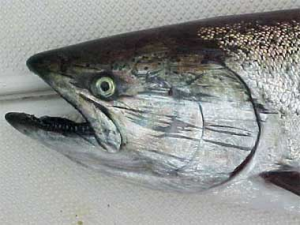
You can tell a fish has been right on the bottom feeding on candlefish when you catch one and it has scrapes on its gill plates like this one does.
Top producing hardware fished off the Scotty downriggers has been a flasher in the glow colors with squid combinations in regular and needlefish sizes. Run these 37-40 inches with 50lb leader with 5/0 Mustad Hooks. Silver Horde Coho Killer and Kingfisher spoons are a good bet when there are candlefish in the area.
Any time you see scratches on the gill plates of a blackmouth its a sure sign they’re feeding on candlefish. Coho Killers are devastating lures when this is taking place.
Give all the spoons an application of Smelly Jelly scent for that extra attraction.
Boat Ramps
Best ramp is Port Townsend for larger boats, it’s a short run from town through the Indian Island cut to Oak Bay. You can launch at Mats Mats Bay, however you need to beware of the tides, any kind of minus tide makes the Mats Mats boat ramp very difficult to use.
Seasons
Salmon seasons can vary, so be sure to check WDFW regulations.
Point No Point / Pilot Point
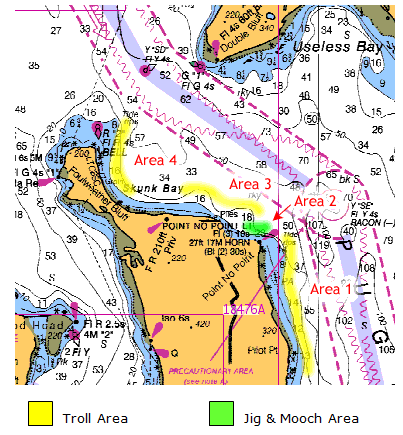
When fishing the Point No Point/Pilot Point area, tidal flow is the driver. Point No Point is always fished on the outgoing tide. Pilot Point produces the vast majority of the salmon catch on the incoming tide.
On the incoming tide, flows and currents are very strong in this area. Bait (herring and candlefish) will be pushed to the down side of Point No Point, and the salmon move with them.
Point No Point offers an excellent opportunity for beach anglers fishing buzz bombs or weighted spoons to catch Chinook, Coho and Chums. Shore anglers should fish the west side of the Point on the outgoing tide and move to the east side on the incoming tide.
The salmon fisherman blessed or cursed with a boat should fish the following areas:
Area 1
Troll with downriggers with the tide in 100 to 150 foot depths. Herring will often suspend in this area, so watch your depth sounder and adjust your lures to just under bait balls. If bait is suspended, 85 to 125 feet deep is usually a good depth for Chinook. If bait is on the bottom, go to the bottom. Sand Lance/Candlefish are usually on the bottom.
On the incoming tide, moochers and jiggers should start at the south side of the rips forming at Point No Point and allow the tide to push you south. Try to stay in 60 to 120 foot depths.
Blackmouth (immature Chinook) are here almost year around, with adult Chinook beginning to show in June and peaking in July/August. Whether you can fish here then, depends on Fish & Wildlife wacky regulations. Ocean Coho start arriving in good numbers about September 5th and fishing remains good into October. Keep your downriggers in the top
60 – 80 feet for good Coho fishing.
Chum arrives in October and November and often in vast schools. Fishing the top 60 feet of water for Chum with a Green Hot Spot Glo flasher and Silver Horde Green Squid or flasher and herring (dyed green) at a slow troll can be very productive.
Area 2
This area is recognized as a drift mooching or jigging area only! Start your drift for Chinook in about 60 feet of water and let the tide push your boat east to west. When you reach about 150 feet of water depth or cant stay on bottom, kick back in. Many anglers are in too deep of water to effectively fish. Its a long productive drift, but the tide can be very strong and swift moving. Try putting your motor in reverse to slow your drift.
Area 3
This is an area that can be trolled with downriggers as long as you give the moochers some space. Follow the 120-ft. to 150-ft. shelf from east to west. Most of your Chinook will be in the bottom 20 feet of the water column. The drop-off will parallel the beach for several hundred yards and then dip in closer to shore.
Area 4
At Foulweather Bluff you will start your troll in the same direction the tide is flowing. This area can be fished on either tide. This bottom is very rocky, so don’t drag your downrigger weights.
Suggested lures for Point No Point/Pilot Point
Chinook – November through April
Coho Killers in Glo colors
#3 Kingfisher Spoons
Needlefish Squid
Chinook – May through September
Silver Horde Sonic Edge Spoons
#35 Silver Horde Squid Green Glo
Coho September through October
Sonic Edge Spoons
Coho Killer Cop car color
Silver Horde Green #35 Squid
Possession Point
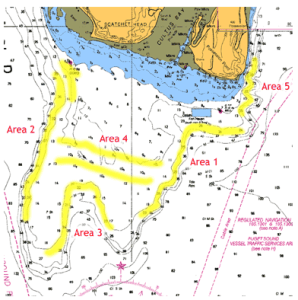
yellow indicates salmon areas
Possession Point is located on the southeast corner of Whidbey Island. However, when you fish Possession, it is actually Possession Bar where your angling takes place. Possession Bar is a huge, underwater structure of reefs that run from Possession Point, west to Scatchet Head. When we refer to Possession, we are for the most part talking about the bar.
Possession holds bait all year long and thus attracts and holds salmon all year long. Vast numbers of summer Chinook, fall Coho, Humpies and Chums pass over this bar on their return to spawn in the Snohomish, Skagit and Stillaguamish river systems. Winter Blackmouth and resident Coho also take advantage of this rich feeding area.
Possession Bar can be a rough area to fish, as the water is very exposed to the wind. The water can quickly become very rough, especially if you have a big tide change coupled with a south wind. The angler with a small boat must be aware of the possibility of rapidly changing sea conditions.
Fishing Possession is very dependent on the tides. As the incoming or outgoing tides sweep across the bar, the baitfish are pushed across the bar and the salmon will follow the bait.
Where to Fish
Area 1
East Side of Possession This is best fished on the incoming tide until one hour after tide change. Fish for Chinook and Blackmouth in the lower 10 feet of your water depth. Try to stay in 90 to 150 feet of water. The bar drops off sharply here and is rocky.

(area 1) yellow indicates salmon areas
Area 2
West Side of Possession Fish from the southern end of the bar towards Scatchet Head. Once again, try to stay in the bottom 10 feet of water depth and in 90 to 150 feet of water.

yellow indicates salmon areas
Area 3
Often referred to as the outer bar. This can be fished on either tide. This is a productive area, as the hole formed by the protective reef structure creates a holding area for bait. Downrigger fishermen must be very aware that once you see the bottom start to climb, you must (1) immediately start your turn to head back out or (2) bring up your downrigger, or both. While many a downrigger ball has been left here, it is a consistent producer of salmon.

yellow indicates salmon areas
Area 4
Although Possession is primarily best fished by trolling; moochers and jiggers can do very well by drifting the outer two-thirds of the bar. Start your drift on the east side of the bar on the outgoing tide and the west side of the bar on the incoming tide. Try to stay in the 60 to 100 foot depths. Possession Bar has numerous holes and dips on top of the bar. Keep in the bottom 10 foot of water and let the tidal flow take you to the salmon.
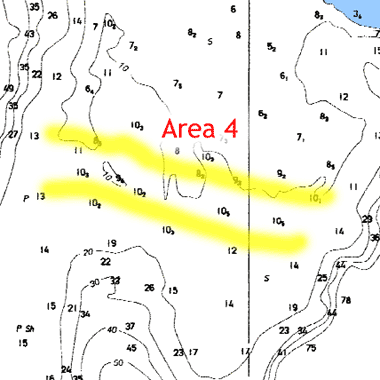
yellow indicates salmon areas
Area 5
Close to Possession Point itself, it is usually referred to by local anglers as the Bait Box hole. This area sits on the edge of a very sharp drop off. Shore anglers casting Buzz Bombs and other weighted jigs can often catch salmon here on the incoming tide.
Boat anglers (moochers and jiggers) will do well on the outgoing tide. They should start in 40 feet of water and let the tide drift them out over the drop offs. They will find they are very close to shore.
Trollers can fish this area in 50 to 100 feet of water. Most downrigger fishermen prefer to bypass this spot and fish the bar itself.
The Bait Box hole is best fished early in the morning or just before dark.
When Coho are in this area, start your early morning angling efforts between 25 to 65 feet deep. As the sun moves higher, drop down to 90 to 150 feet for Coho.
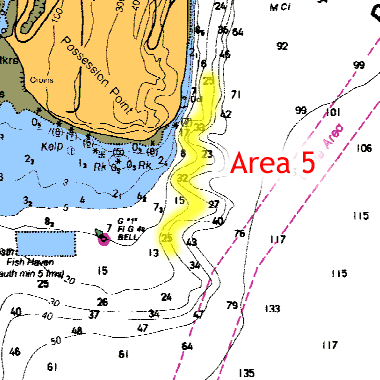
(area 5) yellow indicates salmon areas
Lures
It is very much a match the hatch fishery here. When small bait is in the area, the Silver Horde Coho Killer and #3 Kingfisher spoons are very effective fished behind a Hot Spot flasher. If six inch or larger bait or squid are in the area, then use 5 Silver Horde plugs, No. 35 Squid or Herring.
Boat Launches
The closest boat launch is at Possession Point.
Possession Beach Ramp – Has a seasonal dock and rest rooms. A small fee is charged for launching. This is a nice single lane launch. It has a good slope and traction.
Norton Street Ramp & Everett Marine Park This is the best launch on Puget Sound, with multi ramps and docks. Ample parking is available. The ramps have a good slope and excellent traction. A breakwater provides protection from wind and weather. Fee required.
Mukilteo Ramp – This is the worst boat launch on Puget Sound. It is very exposed to wind and boat traffic. There is a small seasonal dock. During very low tides, your trailer wheels may drop off the end of the ramp. Fee required.
Port Townsend (Mid Channel Bank)
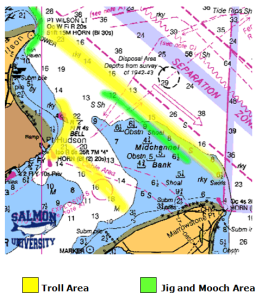 Mid Channel Bank is located just off shore from Port Townsend. It runs from Marrowstone Point on the east, to Point Wilson on the west. Mid Channel Bank has become one of the most popular fishing areas in Puget Sound, as it offers year round Chinook action. Winter blackmouth are there from September to May, followed by summer Chinook starting to show up in June and peaking in July and early August.
Mid Channel Bank is located just off shore from Port Townsend. It runs from Marrowstone Point on the east, to Point Wilson on the west. Mid Channel Bank has become one of the most popular fishing areas in Puget Sound, as it offers year round Chinook action. Winter blackmouth are there from September to May, followed by summer Chinook starting to show up in June and peaking in July and early August.
Be sure to check with WDFW regulations as it opens and closes to salmon fishing at slightly different times every year.
All methods of salmon fishing can be productive at Mid Channel Bank. Moochers and jiggers usually fish the 60 to 100 ft depths. Downriggers are most productive in the 90 to 150 ft depths.
Because of the strong tidal flow along the edge of the bank, trollers are wasting their time trying to troll against the tide. Once you’ve reached the end of your troll, pick up your gear and run back to Marrowstone on an outgoing tide or Pt. Wilson on the incoming tide and start over again. During the brief period of slack tidal current, the salmon will scatter along the bank and can be trolled in either direction.
The most common bait in the winter and spring periods are sandlance (candlefish) especially when they move in to spawn. Keeping that in mind, use small spoons such as the Silver Horde “Coho Killer” and #3 Kingfisher. They work very well here. Also the Gold Star “Needlefish” and Ace Hi Fly’s match the dominant bait in the area.
When the summer Chinook fishing kicks off in early summer, larger bait (herring) will also start to move in and mix with the always-present candlefish. Larger lures such as the Gold Star “Hoochie Hooker” tend to do better on large Chinook. Silver Horde 4 and 5 inch Salmon plugs with glo and rattle, fished 40 feet behind the release clip, catch some of the largest Chinook of the year.
In the summer fishery, Chinook move past Mid Channel Bank on the incoming tide, and unlike the winter fishery, don’t linger in the area. The best tide to fish Mid Channel in the summer is the outgoing tide.
Moochers and Jiggers
Moochers and jiggers will do well by concentrating their efforts on either tide on the Marrowstone (east) side of Mid Channel Bank or off the Point Wilson Lighthouse. In both of these spots, year round the strong currents will push the bait into more shallow water.
Watch for diving birds up on the bank itself. There are holes and pockets that will hold diving birds up on the bank and they are most often over bait. These 40’ to 60’ pockets will also shelter feeding salmon and produce exciting fishing.
Shore Anglers
Anglers who are shore bound can do very well fishing the shoreline at Fort Worden State Park, casting Buzz Bombs and bait under floats. This fishery takes place mainly in the vicinity of the Lighthouse.
Boat Launches
Port of Port Townsend (Boat Haven) – 360-385-2355
Fort Worden State Park – 360-344-4400
Fort Flagler State Park – 360-385-1259
Fort Casey State Park (Whidbey Island) – 360-678-4519
Tulalip Bay
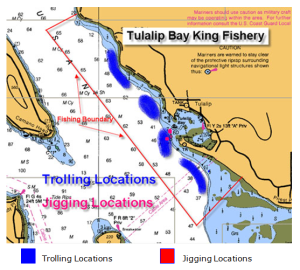 For the North Sound king salmon fisherman “the Bubble” is the best, closest and easiest-access Chinook fishery available.
For the North Sound king salmon fisherman “the Bubble” is the best, closest and easiest-access Chinook fishery available.
Several techniques can be successfully utilized to provoke a strike from these rapidly maturing kings. However, your choice of technique should be heavily influenced by your location in the “Bubble.”
Tulalip Bay can be broken down into an inshore/bottom oriented fishery and an offshore/suspended fishery. Inshore across the bay and on Mission Bar you’ll see jiggers, moochers and sinker/diver trollers all taking fish. Outside however, downriggers dominate the scene and rightly so. Sure, you’ll see the occasional moocher or jigger out there but day in & day out it is very difficult to compete with a good ‘rigger man.
So, where does the inside fishery end and the outside fishery begin? Good question! For the sake of argument I would put the line at the 100-foot mark. This 100-foot demarcation is somewhat arbitrary but holds up in the light of technique-related depth limitations. Simply stated: It’s tough to jig or mooch the bottom effectively at anything deeper than 100 feet.
Offshore Offerings
While the offshore fishery is well attended by the “One Depth Society”, (anglers who lower their gear to a certain depth and keep it there all day) there are many fishermen who work hard at it. Outside fishermen will find their best success using flasher gear (40-60″ leaders) rigged with Kingfisher or Coyote spoons, squid and bucktails. Silver Horde plugs are a good bet outside as well as whole herring rigged in a Pro-Troll Roto-Chip bait holder.
So, what gives you the edge over all of the other outside trollers? Easy, fish at the right depth. Fish where the fish are.
Inside Scoop
While we are targeting suspended (hovering off the bottom) fish in the offshore fishery, once you come inside the focus shifts to kings hugging the bottom. Even though it is possible to troll the bottom closely with downriggers, the accuracy and effectiveness of bouncing a Pt Wilson Dart on the bottom cannot be disputed.
Think of mooching, jigging and trolling as different “solutions” to your fishing “problem”. There are times and tides every day when one technique will out-produce another. Let’s look at a couple of examples.
Ebb and Flood
High tides, particularly in the morning will pull kings into the bay. This is a great time to be trolling inside. If you mark a pile of bait, kings or both then it’s time to pull out the jig rods and drop the darts on their heads. Naturally, this is tough to do if you don’t have a couple of jig sticks pre-rigged and ready to rock. Once the tide starts to ebb and the sun rises in the sky, the kings have two good reasons to get off the flats: loss of depth/cover and increased light level. Anticipate the kings desire to bail out of the bay and get to the edges of the bar and intercept them as they flee to the deep water.
Low tides virtually dry up Tulalip Bay as well as Mission Bar. When this occurs during midday you can rest assured that it is definitely outside trolling time. The edge of the bar is just too shallow, bright and warm to hold kings in the mood to bite. So, look for “pods” of Chinook suspended in the deep water. I’ve caught Tulalip kings with 250′ of wire out in over 300′ of water. The point is that at this time of day (and tide) they could be about anywhere. However, take heart in the fact that once you find them there is quite often more that one. Try to stay on top of the school and if you stop marking them keep your gear at the depth you last observed fish. This is the classic “put in your time” scenario. When you catch a fish remember to stay in the general area and depth range and chances are very good that you’ll double up!
When the flood begins in earnest, keep in mind that the kings will begin to nose up on the bar. This is a very good jigging/mooching situation since the kings will certainly be right on the bottom as they sneak into the bay or up on the bar. Pt Wilson Darts in Green/white, plain white or candlefish (Green, yellow or silver) in the 2 1/2 or 4oz sizes are my favorites. Use only enough jig to keep your jig close to the bottom and your line angle close to vertical. Jigs are designed to display optimum fish attracting action on the DROP! If you start to develop too large of a line angle it becomes difficult to give the lure the slack it requires to work effectively.
How to Fish for Salmon | How to Catch Salmon | How to Fish for Tuna | How to Catch Tuna | How to Fish for Halibut | How to Catch Halibut



